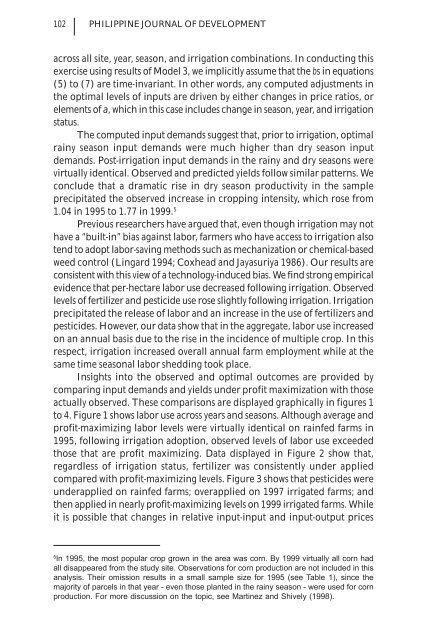Panel Data Evidence from Irrigated Rice Production in Southern
Panel Data Evidence from Irrigated Rice Production in Southern
Panel Data Evidence from Irrigated Rice Production in Southern
Create successful ePaper yourself
Turn your PDF publications into a flip-book with our unique Google optimized e-Paper software.
102 PHILIPPINE JOURNAL OF DEVELOPMENTacross all site, year, season, and irrigation comb<strong>in</strong>ations. In conduct<strong>in</strong>g thisexercise us<strong>in</strong>g results of Model 3, we implicitly assume that the bs <strong>in</strong> equations(5) to (7) are time-<strong>in</strong>variant. In other words, any computed adjustments <strong>in</strong>the optimal levels of <strong>in</strong>puts are driven by either changes <strong>in</strong> price ratios, orelements of a, which <strong>in</strong> this case <strong>in</strong>cludes change <strong>in</strong> season, year, and irrigationstatus.The computed <strong>in</strong>put demands suggest that, prior to irrigation, optimalra<strong>in</strong>y season <strong>in</strong>put demands were much higher than dry season <strong>in</strong>putdemands. Post-irrigation <strong>in</strong>put demands <strong>in</strong> the ra<strong>in</strong>y and dry seasons werevirtually identical. Observed and predicted yields follow similar patterns. Weconclude that a dramatic rise <strong>in</strong> dry season productivity <strong>in</strong> the sampleprecipitated the observed <strong>in</strong>crease <strong>in</strong> cropp<strong>in</strong>g <strong>in</strong>tensity, which rose <strong>from</strong>1.04 <strong>in</strong> 1995 to 1.77 <strong>in</strong> 1999. 5Previous researchers have argued that, even though irrigation may nothave a “built-<strong>in</strong>” bias aga<strong>in</strong>st labor, farmers who have access to irrigation alsotend to adopt labor-sav<strong>in</strong>g methods such as mechanization or chemical-basedweed control (L<strong>in</strong>gard 1994; Coxhead and Jayasuriya 1986). Our results areconsistent with this view of a technology-<strong>in</strong>duced bias. We f<strong>in</strong>d strong empiricalevidence that per-hectare labor use decreased follow<strong>in</strong>g irrigation. Observedlevels of fertilizer and pesticide use rose slightly follow<strong>in</strong>g irrigation. Irrigationprecipitated the release of labor and an <strong>in</strong>crease <strong>in</strong> the use of fertilizers andpesticides. However, our data show that <strong>in</strong> the aggregate, labor use <strong>in</strong>creasedon an annual basis due to the rise <strong>in</strong> the <strong>in</strong>cidence of multiple crop. In thisrespect, irrigation <strong>in</strong>creased overall annual farm employment while at thesame time seasonal labor shedd<strong>in</strong>g took place.Insights <strong>in</strong>to the observed and optimal outcomes are provided bycompar<strong>in</strong>g <strong>in</strong>put demands and yields under profit maximization with thoseactually observed. These comparisons are displayed graphically <strong>in</strong> figures 1to 4. Figure 1 shows labor use across years and seasons. Although average andprofit-maximiz<strong>in</strong>g labor levels were virtually identical on ra<strong>in</strong>fed farms <strong>in</strong>1995, follow<strong>in</strong>g irrigation adoption, observed levels of labor use exceededthose that are profit maximiz<strong>in</strong>g. <strong>Data</strong> displayed <strong>in</strong> Figure 2 show that,regardless of irrigation status, fertilizer was consistently under appliedcompared with profit-maximiz<strong>in</strong>g levels. Figure 3 shows that pesticides wereunderapplied on ra<strong>in</strong>fed farms; overapplied on 1997 irrigated farms; andthen applied <strong>in</strong> nearly profit-maximiz<strong>in</strong>g levels on 1999 irrigated farms. Whileit is possible that changes <strong>in</strong> relative <strong>in</strong>put-<strong>in</strong>put and <strong>in</strong>put-output prices5In 1995, the most popular crop grown <strong>in</strong> the area was corn. By 1999 virtually all corn hadall disappeared <strong>from</strong> the study site. Observations for corn production are not <strong>in</strong>cluded <strong>in</strong> thisanalysis. Their omission results <strong>in</strong> a small sample size for 1995 (see Table 1), s<strong>in</strong>ce themajority of parcels <strong>in</strong> that year - even those planted <strong>in</strong> the ra<strong>in</strong>y season - were used for cornproduction. For more discussion on the topic, see Mart<strong>in</strong>ez and Shively (1998).










